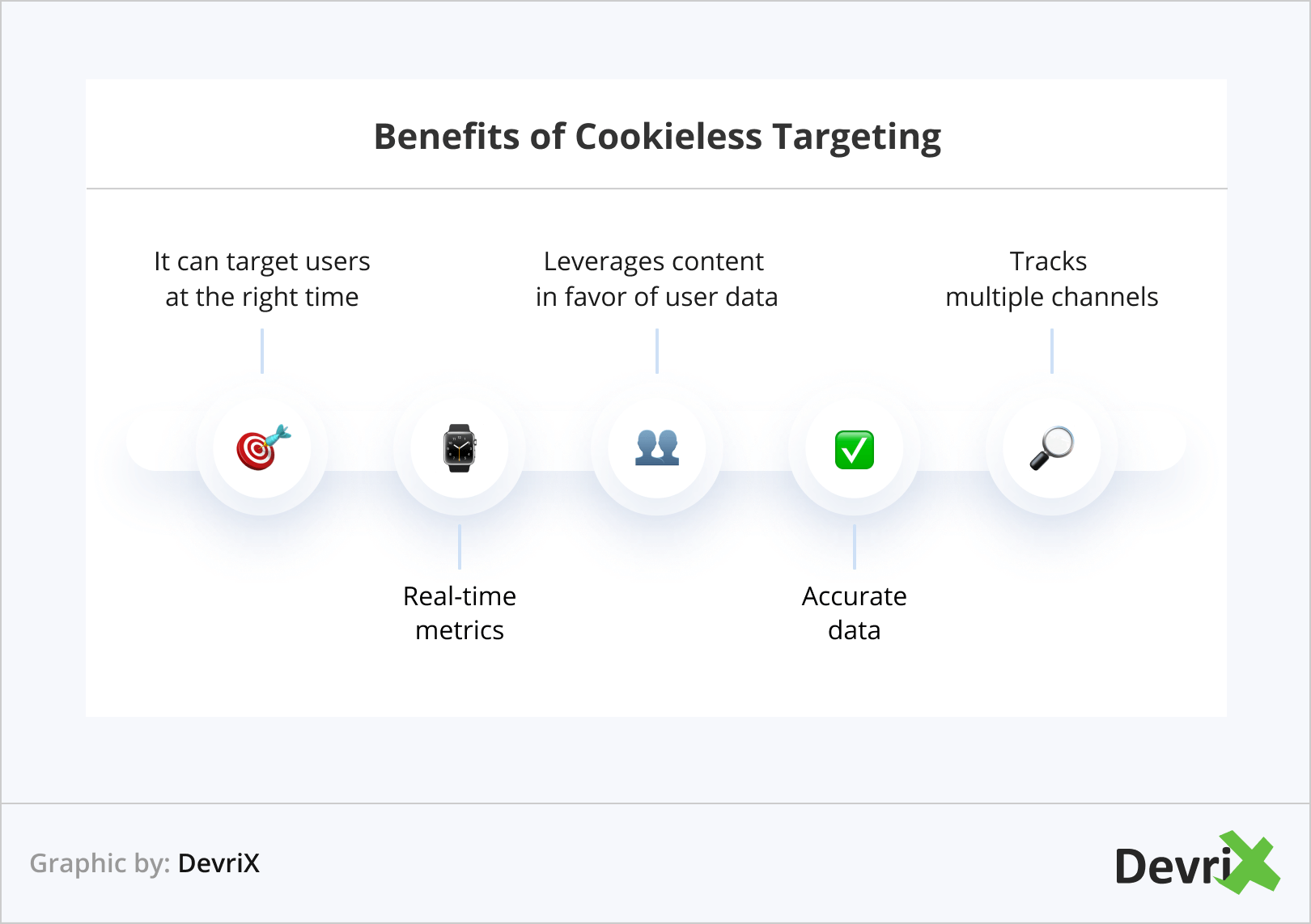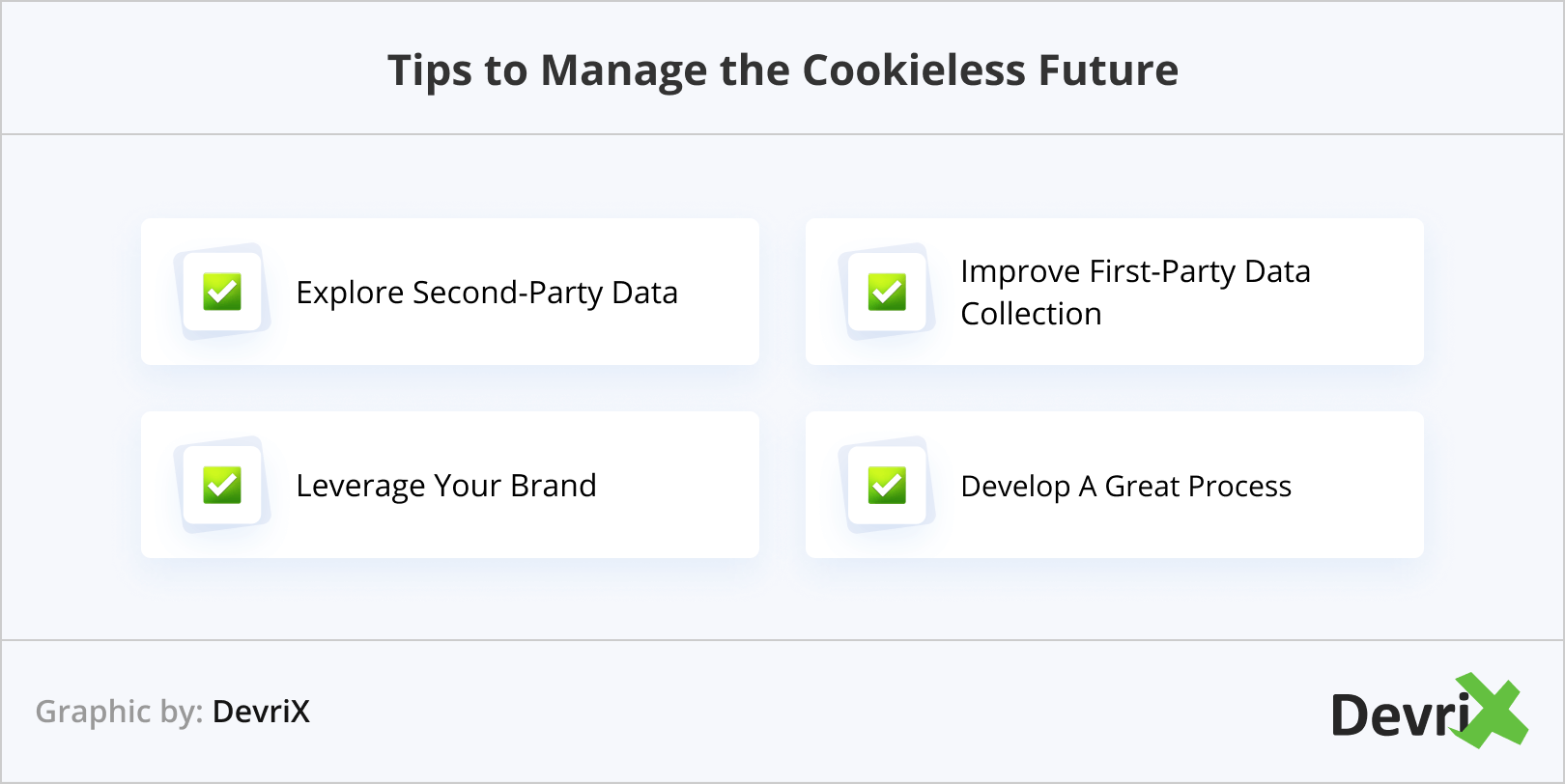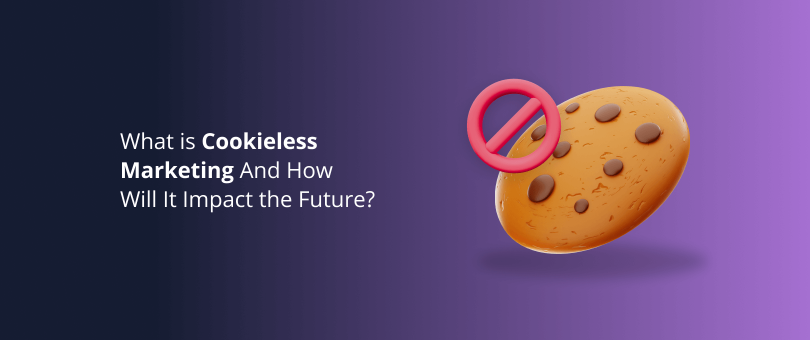Can you imagine living in a world without cookies?
Fear not, Cookie Monster, we are not talking about those cookies. From the position of a WordPress agency focused on data, performance, and growth traffic, we are referring to the third-party cookies that websites use to track, personalize and save information about user sessions.
Cookieless marketing follows the increasing concern about online data privacy, not to mention the annoying user experience they can create.
What does this mean for businesses, though? How are they going to collect user data, in order to provide a personalized experience, and target their audience relevantly?
Stay tuned, as we find the answers to these questions, and more.
Readers Also Enjoy: How to Balance Personalization and Privacy in Digital Marketing – DevriX
What Is Cookieless Marketing?
Cookieless marketing is a method of targeting users without using third-party cookies or other tracking methods.
One of the major drawbacks of cookies is that they could potentially violate the privacy of users. In recent years, there has been a major shift from the big players on the market to stop the use of cookies.
Google officially announced that they will stop the use of third-party cookies on their browser Chrome (the browser with over 63% global market share) by the end of 2023. Firefox blocked third-party cookies by default back in 2019, and Safari did the same in 2020.
What is more, tech giant Apple announced that they will be making changes to the Identifiers for Advertisers (IDFAs). This will allow users to block them at an app level.
Ultimately, a cookieless future is upon us, so how should marketers and businesses prepare for it? Let us find out.
Interesting fact: Louis Montulli II invented the term “cookies” back in 1994. It came from the term “magic cookie”, used by Unix programmers. It refers to a data package that receives and then sends back data unchanged. The “magic cookie” term itself derived from the popular “fortune cookies”.
Readers Also Enjoy: What Are The Benefits of Big Data Analytics? – DevriX
How to Apply Cookieless Marketing?

- Use First-Party Data
- Build an Email List
- Apply Device Fingerprinting
- Rely on Contextual Marketing
- Go all in on Personalization Tactics
1. Use First-Party Data
First-party data (also known as 1P data) is essentially different from third-party data. You see, first-party data is collected directly from your audience, be it from website sign-ups, lead generation, social media followers, email subscribers, customer survey respondents, and so on.
Basically, every piece of information you have collected about your customers is considered first-party data. This means that you can safely utilize tools like Google Analytics, HubSpot, Salesforce, AdRoll, etc.
On the other hand, third-party data collection that sells data, will become obsolete. In practice, you will not be able to obtain information about a user’s browsing history, and habits, outside your own website.
In practice, when someone visits your website for the first time, you will not be able to instantly provide targeted ads. Instead, you will have to start from the basics, and ask:

Readers Also Enjoy: Tips for Publishers: How to Handle Data Asset Management – DevriX
2. Build an Email List
Email communication has always had a significant impact in the world of marketing, and that impact is just going to become even more important.
Growing an email list will help businesses grow their audience with users that are truly interested in the products or services they offer.
This is a fact, since the person must provide his own email address. What this means is that they are willingly giving you the permission to contact them.
On top of that, email marketing is an awesome way to start a two-way conversation, provide special offers to users, and personalize their experience.
Readers Also Enjoy: 9 Email Marketing Secrets to Boost Your Campaigns – DevriX
3. Apply Device Fingerprinting
A great tip on how to prepare for the cookieless future is to utilize device fingerprinting. It is a technology that collects information about a user’s device – operating system, IP address, browsers, and so forth, thus creating a unique fingerprint.
Of course, this technology is not without its flaws, yet it could be of help to marketers, looking for a general outline on user preferences.
Readers Also Enjoy: 11 Technology Trends in Business to Look Forward to in 2023 – DevriX
4. Rely on Contextual Marketing
Contextual marketing is a powerful online advertising tool, and it can be even more important in a cookieless world. It works mainly around the personalization aspect of targeting – delivering the proper message to the right audience at the right time.
In fact, the three main elements of contextual marketing are relevance, personalization, and targeting. Overall, it can be quite helpful not only to adapt to a world without cookies, but it can also help you to increase conversion rates, and strengthen your brand.
Readers Also Enjoy: How to Achieve a Memorable Integrated Marketing Campaign – DevriX
5. Go All in on Personalization Tactics
To be honest, a lot of marketers have gotten lazy due to the third-party cookies presenting them with all the information they require. Well, now is the perfect time to rethink marketing strategies, and put an extra emphasis on being creative, especially when it comes to personalization.
For example, you can apply smart geo-targeting to attract online shoppers, as well as, to market local products and services. Moment marketing is another tactic that can be super useful for personalization. Generally, the creativity of your marketing team should overcome the potential setbacks of no third-party cookies.
Readers Also Enjoy: What Do Customers Want? 9 Things to Do Now – DevriX
Benefits of Cookieless Targeting

Cookieless advertisement targeting is actually quite beneficial to a lot of brands. Let us take a look at why:
- It can target users at the right time. Cookieless ads targeting, believe it or not, can help you target users more effectively, and at the right time. For example, when a person is browsing for books, it is only logical that they are receptive to ads about bookstores, and book accessories. Therefore, it’s probably best to target them at that specific time.
- Real-time metrics. The use of programmatic advertising allows you to view metrics and data in real-time. This, on its own, can help you to optimize your campaigns for maximum effectiveness. Additionally, you can review whether your ads are being displayed in the relevant domains, thus permitting you to change the keywords and topics you have selected in real-time.
- Leverages content in favor of user data. Content is the most important asset of your website. Users do not visit your site to accept tracking cookies, they visit in order to access your content. Then, they may decide whether to purchase something from you or not. Using contextual marketing, you can research and analyze the psychographics of your audience and set up the appropriate ads. For example, you can target people that are interested in eating well by placing bids for keywords like “healthy foods ideas” and “healthy high calorie foods”.
- Accurate data. One of the major drawbacks of cookie tracking is that it is not 100% accurate. In fact, using cookies will only provide around 60% of website visitor data. On the other hand, AI data collection solutions can provide up to 100% of website visitor data, which, in practice, gives you 40% more insights regarding user behavior, and their interactions with your website.
- Tracks multiple channels. Since cookies are tied to specific browsers, they are only able to give you data from the users’ usage of said browsers. Nowadays, though, people are accessing the internet from multiple devices – mobile phones, laptops, tablets, smart TVs, gaming consoles, home appliances, and so on – this means that you are not fully able to see the entire customer journey. Using a cookieless approach, on the other hand, provides you with an all-inclusive overview of your customer’s journey – from the initial point of contact to the post-transactional actions. This can help you achieve an accurate picture of your audience and how they interact with your website.
Readers Also Enjoy: Omnichannel Marketing: The Definitive Guide – DevriX
Tips to Manage the Cookieless Future

Whether you like it or not, the rules of the game are changing, so you’d better adapt quickly, or risk falling behind and putting your business on the line. Do not hesitate, instead focus on developing your strategy.
Here are some tips to help you:
- Explore second-party data. Second-hand, or second-party data, as this implies, is data that you do not collect yourself. Businesses often form strategic partnerships with other companies that are mutually beneficial, in terms of sharing insights on user behavior, and other important data. You can use, for instance, Google Ads, and/or Facebook Ads Manager to obtain any audience data they have collected previously. Plus, it is free of charge.
- Improve first-party data collection. As we’ve mentioned earlier, the importance of first-party data is going to increase significantly. Therefore, it is a good idea to think of ways to improve the way you collect information. Essentially, enhancing the quality of your first-party data collection will provide you with excellent opportunities to target and personalize the interactions of those who have interacted with your brand. Additionally, you should keep in mind that the earlier you start this process the better, since you will need time to gather sufficient data.
- Leverage your brand. You should focus on your brand, and not on the cookies, as a great brand experience is what can turn visitors into customers. What is more, brand marketing can lead to a greater long-term customer loyalty, and establish close relationships with your clients. Not to mention, unlike cookies, a brand experience is not annoying, and invasive.
- Develop a great process. Developing your brand and understanding your customer-base is a continuous process that requires a lot of effort, hard work, and dedication. Think about all the steps needed to make a great customer journey, and how you can leverage this information to provide the best possible customer experience The key to successful, future-proof cookieless marketing lies in unique products/services, outstanding customer service, innovation, personalization, and so on.
Readers Also Enjoy: Customer Intelligence 101: Your Guide to Winning the Customer’s Heart – DevriX
Conclusion
Ready or not, the cookieless future is here. As the Bob Dylan song goes, “the times they are a-changin’”, and the best you can do is to prepare.
Truth be told, cookieless marketing is not a bad thing. It is going to allow marketers to focus on much more important and sustainable marketing approaches, including brand marketing, personalization, and contextual marketing.
On top of that, businesses will have more opportunities to target their audiences better, and allocate more resources into their brand experience.



![[Infographic] 24 Fundamental Email Marketing Stats](https://devrix.com/wp-content/uploads/2018/01/Infographic-24-Fundamental-Email-Marketing-Stats-380x160.png)
